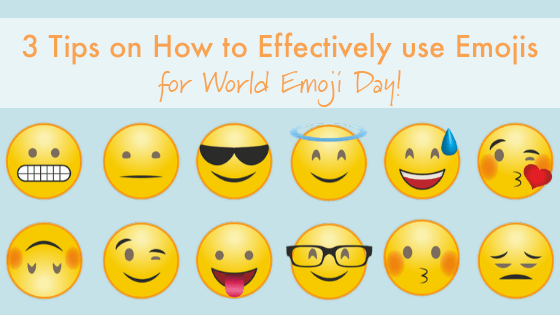
3 Tips for Effectively Using Emojis

From the simple smiley face to the now 3,664 other emojis that exist in the Unicode Standard (according to emojipedia.org), these little symbols have been adding emotion (hence the name), personality, and sometimes confusion to writing for more than 20 years. In celebration of World Emoji Day on July 17, we’re offering three quick tips on how to effectively and appropriately use emojis to connect with your audience.
1. Use Emojis to Capture Attention
Visual elements (images, video, etc.) naturally draw the eye and help viewers connect to the content they are consuming. This is true across many print and digital mediums, including social media feeds, web pages, and traditional advertising. Images are also more quickly understood by the human brain than text – which is important to know and use in today’s hyper-fast world.
A captivating image or video is a great tool to help your content stand out among the clutter. But what about content that has no visual component like email subject lines or mobile messages? Using emojis in content that is traditionally “text only” enables you to capture your reader’s eye in ways plain text cannot.
2. Don’t Overdo It!
Yes, emojis can help capture attention, but their presence shouldn’t feel unnatural. Forcing emojis into your content for the sake of using them can make your content look spammy and leave a negative impression on your audience. Always think about quality over quantity.
Instead, utilize emojis sparingly and choose them wisely based on your brand voice. A simple, natural way to include emojis is to replace a word in your text with its respective symbol. For example, your audience will naturally translate “Happy Emoji Day!” to “Happy World Emoji Day!” without any explanation needed.
3. Be Mindful of Misinterpretation
Though emojis have become commonplace in modern digital conversation, there’s always a risk of miscommunication. Emojis can appear differently or even be illegible across different devices and platforms, leaving your audience wondering what ⮽ was supposed to be.
In addition to differences in symbols, many emojis can be interpreted as having different meanings. For example: ♀️ is formally titled “Information Desk Woman” by Apple and is supposed to designate someone being helpful or offering to answer a question. However, it is most commonly used to convey sassiness or sarcasm.
While this is just one example of a common misinterpretation, many emojis were designed to express one emotion and have quickly become associated with a different meaning. Emojipedia is a handy reference as it will give you the commonly understood meaning or connotation of an emoji. But another good rule to follow – when in doubt, leave it out. It’s best to avoid a possible miscommunication or PR blunder due to misappropriate use of an emoji.
As with any content implementation, it’s always important to test the waters and compare results to determine what is eliciting the best response from your audience.
Our digital team is well-versed in the language of emojis and can help you improve your business’s digital content strategies overall. For more information on how we may be able to help you, contact us.
You May Like

The Importance of Setting Goals - for Career Success
Recently we had the opportunity to attend The Blue Chip Awards Luncheon. A wonderful afternoon filled with successful small business people, great food and inspirational stories, the highlight was key speaker, Nikki Stone. An Olympic gold medalist, Nikki overcame much adversity and physical challenges throughout her career and stressed the

Networking: For Business and PR
Networking and communication used to take the traditional path of print advertising and brochures, direct mail, local/national trade shows, etc. These forms of communicating your brand/business still exist but more often they are used in balance with modern forms of networking and sharing information about you and your business. Here

The Media Pitch: How To Tell Your Story
Do you have an event or story that you would LOVE the media to pick up, but you're not sure how to get their attention? With so much going on in the news on a day to day basis, it is important that your event or story stands out from